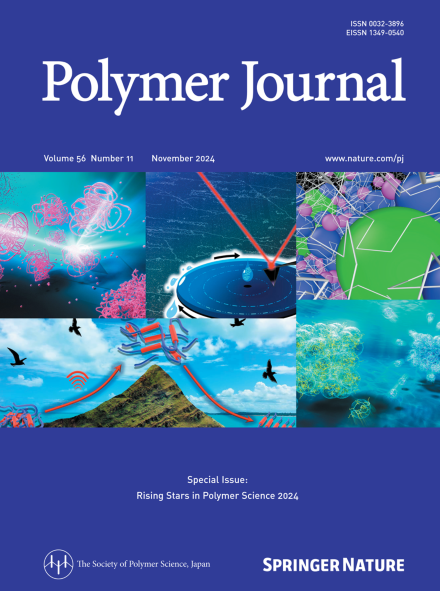A deeper dive into primitive polylactate polymerization and microdroplet assembly under restrictive early Earth conditions
IF 2.7
4区 化学
Q3 POLYMER SCIENCE
引用次数: 0
Abstract
Alpha hydroxy acids (AHAs) play various roles in modern biology such as in metabolism, but could have played different roles as “non-biomolecules” at the origins of life. Specifically, lactic acid (LA) and other AHAs can polymerize into polyesters and subsequently assemble into membraneless microdroplets (MMDs) upon dehydration-rehydration cycles, suggesting that polyester MMDs could have been relevant protocell models on early Earth. However, in particular, how the harsh conditions of early Earth, namely salinity and decreased reactant volume/concentration, could have affected primitive LA polymerization and subsequent MMD assembly is unclear. In this study, we found that while monovalent salts such as NaCl and KCl did not inhibit LA polymerization and MMD assembly even at high concentrations (up to 1 M), divalent salts such as MgCl2 and CaCl2 were inhibitory at much lower concentrations. Additionally, we found that lower reaction volumes and concentrations, potentially simulating confined microenvironments on early Earth, still supported LA polymerization and MMD assembly to some extent, albeit with decreased efficiency. These results suggest that early Earth’s environmental conditions could have still supported the polymerization of LA and the formation of MMD-based protocells in a variety of settings despite being quite harsh and variable. Lactic acid (LA), likely abundant on early Earth, can polymerize into polyesters and assemble into membraneless microdroplets (MMDs). However, how the harsh conditions of early Earth could have affected primitive LA polymerization and subsequent MMD assembly is unclear. In this study, we probed the effect of salinity, reaction volume, and reaction concentration on primitive LA polymerization and subsequent MMD assembly, and find that early Earth’s harsh environmental conditions could have still supported the formation of LA-based MMD protocells in a variety of settings.

深入研究早期地球条件下的原始聚乳酸聚合和微滴组装
果酸在现代生物学中发挥着多种作用,例如在新陈代谢中,但在生命起源时作为“非生物分子”可能发挥着不同的作用。具体来说,乳酸(LA)和其他氨基酸可以聚合成聚酯,随后在脱水-再水合循环中组装成无膜微滴(MMDs),这表明聚酯微滴可能是早期地球上相关的原始细胞模型。然而,特别是早期地球的恶劣条件,即盐度和反应物体积/浓度的降低,如何影响原始LA聚合和随后的MMD组装尚不清楚。在这项研究中,我们发现,虽然一价盐如NaCl和KCl即使在高浓度(高达1 M)下也不会抑制LA聚合和MMD组装,但二价盐如MgCl2和CaCl2在低浓度下也有抑制作用。此外,我们发现较低的反应体积和浓度,可能模拟早期地球上受限的微环境,仍然在一定程度上支持LA聚合和MMD组装,尽管效率降低了。这些结果表明,早期地球的环境条件可能仍然支持LA的聚合,并在各种环境下形成基于mmd的原始细胞,尽管条件相当苛刻和多变。乳酸(LA)可能在早期地球上大量存在,它可以聚合成聚酯并组装成无膜微滴(MMDs)。然而,早期地球的恶劣条件如何影响原始LA聚合和随后的MMD组装尚不清楚。在这项研究中,我们探讨了盐度、反应体积和反应浓度对原始LA聚合和随后的MMD组装的影响,并发现早期地球的恶劣环境条件仍然可以在各种环境下支持基于LA的MMD原始细胞的形成。
本文章由计算机程序翻译,如有差异,请以英文原文为准。
求助全文
约1分钟内获得全文
求助全文
来源期刊

Polymer Journal
化学-高分子科学
CiteScore
5.60
自引率
7.10%
发文量
131
审稿时长
2.5 months
期刊介绍:
Polymer Journal promotes research from all aspects of polymer science from anywhere in the world and aims to provide an integrated platform for scientific communication that assists the advancement of polymer science and related fields. The journal publishes Original Articles, Notes, Short Communications and Reviews.
Subject areas and topics of particular interest within the journal''s scope include, but are not limited to, those listed below:
Polymer synthesis and reactions
Polymer structures
Physical properties of polymers
Polymer surface and interfaces
Functional polymers
Supramolecular polymers
Self-assembled materials
Biopolymers and bio-related polymer materials
Polymer engineering.
 求助内容:
求助内容: 应助结果提醒方式:
应助结果提醒方式:


